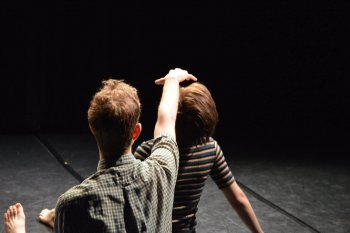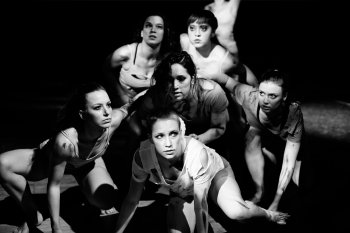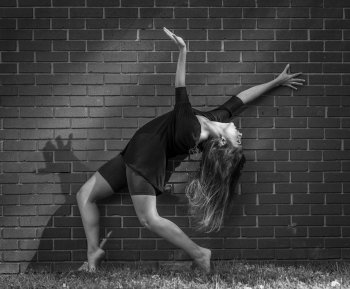Newsteps: a choreographers series
An evening of dark, but promising works.
[avatar user=”Joel Benjamin” size=”96″ align=”left” ] Joel Benjamin, Critic[/avatar]Question: Why are these five young choreographers so unhappy, so full of angst and disquietude? There’s nothing wrong with exploring the darker side of life, but virtually all of the works presented in the 22nd anniversary chapter of Chen Dance Center’s Newsteps were either dreary or darkly agitated which probably should be taken as a sign of the psychological state of today’s younger artists. Even the one piece that seemed to have a dreamy quality quickly turned sour.
That work was “Stay with Me” by Ayaka Kamei which found Seneca Lawrence, in a long, filmy dress lying on the floor. As the ironically calm score by Oda Kazumasa and Zoe Keating played, she stirred, stretching prettily. Soon, little signs of agitation set in: anxious reaches, nervous eyes, a hand scratching her thigh. She rose tentatively only to return to the floor. Suddenly the lights took on a reddish glow and she became frightened, running to and fro. In the end, she resumed the opening pose, this time as if exhausted, readying herself for a restless sleep.
“What We’re In Now” was choreographed by Hannah Garner who performed it with Will Noling, both sweet looking, both dressed in casual street wear. The two were first discovered sitting coyly on two chairs shoved together. They eyed each other, looked warily about and attempted to touch each other as an Italian pop song by Armando Trovajoli played. They then displayed a very mixed-up relationship involving wrestling, rolling about on the floor, jiggling their upraised legs and otherwise abusing each other. At one point, he grabbed his belly as if wounded, then pointedly moved the chairs to a different position. As quiet guitar music superseded the song they reunited only to descend into fitful, flailing movements as the lights faded. Ms. Garner’s movement choices were purposely limited, relying more on emoting than dance.
“The Scar,” by Laura Henry pitted five women—Audra Edwards, Alison Giampolo, Marissa Graham, Jenna Rifkind and Ambere Rogers—in Amazon mode, their faces streaked with dirt, their outfits shredded, against both each other and some unseen outside force. A voice intoned: “Maybe there is a beast; maybe it’s us!” They strutted; moved en masse; focused on an individual; appeared to be hunting; leaped about in a frenzy; twisted their bodies; but never did seem to catch “the beast.” The effectively spare score was by Dj Juri (remixed by Brett Copeland) and Olfafur Arnalds.
“The time,” a duet by Takeshi Ohashi, a neurotic take on Adam and Eve, complete with that apple, was danced effectively by Maki Shinagawa and Vivake Khamsingsavath who took turns peeling that piece of fruit with a paring knife. Ärvo Part’s piano music provided a quiet, throbbing backdrop to the unraveling relationship. He crouched down front dealing with the apple he purloined from her while she moved about, then vice versa. Even when they actually touched, there was little erotic heat. The duet was more in the way of an extended squabble, the fadeout promising only more of the same.
The cast of the final work, “Quiet,” by Gina Montalto, suffered a loss, so a quartet became a trio. How it affected the work, only Ms. Montalto, who was part of the remaining threesome, knows. “Quiet,” to gently repetitive, but dramatic music by Philip Glass, had the strongest erotic content of all the five works on the program, as the three dancers—Elliott Keller and Sarina Taggart completed the cast—circled each other in crouching walks, sometimes warily do-si-do-ing. Atop supple upper body movements, nervous hands covered faces and touched upper bodies. They barely touched and ended in crouched positions, their faces pictures of unhappiness. Even though the title was “Quiet,” it should have been “Disquiet.”
All the choreographers had a decent kinetic awareness and there were germs of more complexly expressive works in each of these five ballets. None of the choreographers, however, can yet develop a long phrase, let alone build a mature dance piece, even in these works, none longer than ten minutes. Repetition was the most often used technique. The second most obvious conceit was the use of hand gestures such as stroking faces, body parts or reaching out with clenched fists or tensed digits. That’s okay for ten minutes, but is a creative dead end.
However, the most serious technical flaw that these young dance makers shared is the inability to understand that there can be no sorrow or sadness without happiness and uplift.
A wise lighting designer once put me in my place when I, in a former life was a choreographer, insisted that she light a short duet of mine only in red, to emphasize the bloody, deathly gloom of the work. (All right, I admit I went through the same phase these youngsters are going through!) She quietly showed me that by using a bit of green, a bit of pink and even a bit of white between the dramatic red gelled lights, the audience would better perceive the “deathly red” effect I wanted. This is a lesson these five young artists have to contemplate.
Speaking of lighting designers, Joe Doran, the creator of all the lighting designers for these works, truly gave each its own look.
Newsteps: a choreographers series (January 14-16, 2016)
Chen Dance Center, 70 Mulberry Street, 2nd Floor, in Manhattan
For tickets, call 212-349-0438 or visit http://www.newsteps2016-chendance.eventbrite.com
Running time: 55 minutes with no intermission









Leave a comment